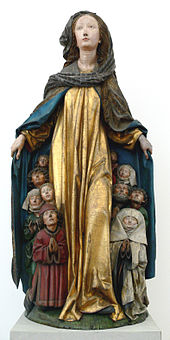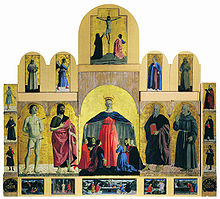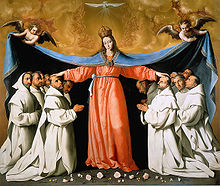
An icon is a religious work of art, most commonly a painting, in the cultures of the Eastern Orthodox, Oriental Orthodox, and Catholic churches. The most common subjects include Jesus, Mary, saints, and angels. Although especially associated with portrait-style images concentrating on one or two main figures, the term also covers most of the religious images in a variety of artistic media produced by Eastern Christianity, including narrative scenes, usually from the Bible or the lives of saints.

In art, a Madonna is a representation of Mary, either alone or with her child Jesus. These images are central icons for both the Catholic and Orthodox churches. The word is from Italian ma donna 'my lady' (archaic). The Madonna and Child type is very prevalent in Christian iconography, divided into many traditional subtypes especially in Eastern Orthodox iconography, often known after the location of a notable icon of the type, such as the Theotokos of Vladimir, Agiosoritissa, Blachernitissa, etc., or descriptive of the depicted posture, as in Hodegetria, Eleusa, etc.

The term Black Madonna or Black Virgin tends to refer to statues or paintings in Western Christendom of the Blessed Virgin Mary and the Infant Jesus, where both figures are depicted with dark skin. Examples of the Black Madonna can be found both in Catholic and Orthodox countries.

The Black Madonna of Częstochowa, also known as Our Lady of Częstochowa is a venerated icon of the Blessed Virgin Mary housed at the Jasna Góra Monastery in Częstochowa, Poland.
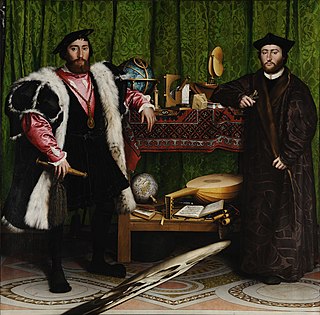
Iconography, as a branch of art history, studies the identification, description and interpretation of the content of images: the subjects depicted, the particular compositions and details used to do so, and other elements that are distinct from artistic style. The word iconography comes from the Greek εἰκών ("image") and γράφειν.
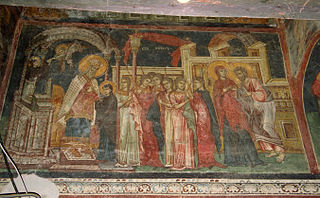
The Presentation of the Blessed Virgin Mary, known in the East as The Entry of the Most Holy Theotokos into the Temple, is a liturgical feast celebrated on November 21 by the Catholic, Eastern Orthodox, and some Anglo-Catholic Churches.

Salus Populi Romani is a Catholic title associated with the venerated image of the Blessed Virgin Mary in Rome. This Byzantine icon of the Madonna and Child Jesus holding a Gospel book on a gold ground, now heavily overpainted, is kept in the Borghese (Pauline) Chapel of the Santa Maria Maggiore. Pope Francis has constructed a burial vault near the icon, intended to be his final resting place.

The Intercession of the Theotokos, or the Protection of Our Most Holy Lady Theotokos and Ever-Virgin Mary, is a Christian feast of the Mother of God celebrated in the Eastern Orthodox and Byzantine Catholic Churches on October 1 . The feast celebrates the protection afforded the faithful through the intercessions of the Theotokos.
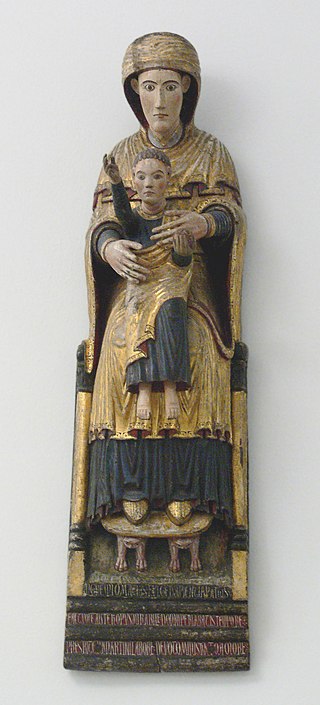
Seat of Wisdom or Throne of Wisdom is one of many devotional titles for Mary in Roman Catholic tradition. In Seat of Wisdom icons and sculptures, Mary is seated on a throne with the Christ Child on her lap. For the more domestic and intimate iconic representations of Mary with the infant Jesus on her lap, see Madonna and Child. The Roman Catholic Church honors Mary, Seat of Wisdom, with a feast day on June 8.

A Hodegetria, or Virgin Hodegetria, is an iconographic depiction of the Theotokos holding the Child Jesus at her side while pointing to him as the source of salvation for humankind. The Virgin's head usually inclines towards the child, who raises his hand in a blessing gesture. Metals are often used to draw attention to young Christ, reflecting light and shining in a way to embody divinity. In the Western Church this type of icon is sometimes called Our Lady of the Way.

The icon of Our Lady of the Sign or Platytera is the term for a particular type of icon of the Theotokos, facing the viewer directly, depicted either full length or half, with her hands raised in the orans position, and with the image of the Child Jesus depicted within a round aureole upon her breast.

Mary, the mother of Jesus in Christianity, is known by many different titles, epithets, invocations, and several names associated with places.

The Eleusa is a type of depiction of the Virgin Mary in icons in which the Christ Child is nestled against her cheek. In the Western Church the type is often known as the Virgin of Tenderness.
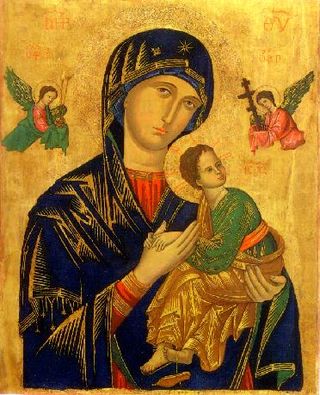
Mary has been one of the major subjects of Western art for centuries. There is an enormous quantity of Marian art in the Catholic Church, covering both devotional subjects such as the Virgin and Child and a range of narrative subjects from the Life of the Virgin, often arranged in cycles. Most medieval painters, and from the Reformation to about 1800 most from Catholic countries, have produced works, including old masters such as Michelangelo and Botticelli.

The Bosom of Abraham Trinity, also known as the Trinity with souls, is a rare iconography apparently unique to English medieval alabaster sculpture, of which only twelve examples are known to have survived, although there were undoubtedly many more made. They adapt an earlier convention where a figure of Abraham himself held tiny figures of souls in a cloth between his hands representing the Bosom of Abraham.

The Virgin of the Navigators is a painting by Spanish artist Alejo Fernández, created as the central panel of an altarpiece for the chapel of the Casa de Contratación in Alcázar of Seville, Seville, southern Spain. Scholars date the painting to sometime between 1531 and 1536. Carla Rahn Phillips has suggested that it represents Christopher Columbus as a European magus-king reinforcing "the notion that the Spanish Empire represented the fulfillment of biblical prophecy to bring the Christian message to all the peoples of the world.
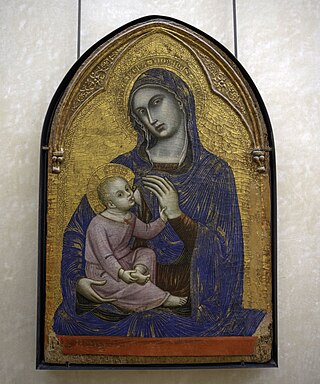
The Nursing Madonna, Virgo Lactans, or Madonna Lactans, is an iconography of the Madonna and Child in which the Virgin Mary is shown breastfeeding the infant Jesus. In Italian it is called the Madonna del Latte. It was a common type in painting until the change in atmosphere after the Council of Trent, in which it was rather discouraged by the church, at least in public contexts, on grounds of propriety.

The Panagia Agiosoritissa or Hagiosoritissa is the name for a type of Marian icon, showing Mary without child, slightly from the side with both hands raised in prayer. The type is known in Latin as Maria Advocata.

The Madonna della Clemenza is a panel painting in encaustic, variously dated between the 6th and 9th century, in the Basilica Santa Maria in Trastevere, Rome, Italy. It is an icon of the enthroned Virgin and Child. The origins of the painting are debated among scholars, but it is regarded as having been produced in Rome, perhaps commissioned by the ethnically Greek Pope John VII, one of the Byzantine popes, which would help to account for the especially strong Greek elements. The Madonna della Clemenza is one of the five oldest existing Marian Icons from the medieval period. Its proximity to the rise of Christianity is one of the reasons it was believed to be a divine image. It is the largest of the five at 164 x 116 cm.
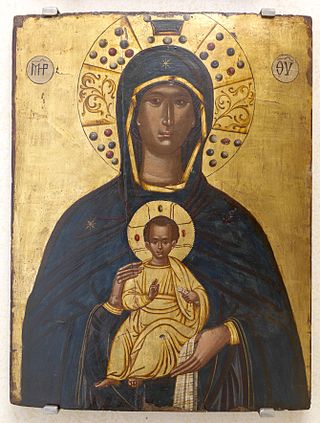
The Virgin Nikopoios also known as Panagia Nikopoios is a tempera painting by Thomas Bathas. Bathas was active in Heraklion, Venice, and Corfu during the second half of the 16th century. The painting follows the traditional Byzantine style characteristic of the traditional maniera greca. The painting also featured the Venetian style. The position of the Virgin and Child is the Nikopoios. The word Nicopeia is indicative of Constantinople. There are actually many different types.

